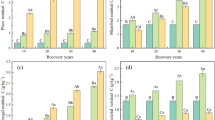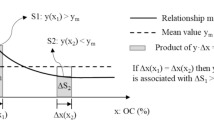Abstract
Afforestation and reforestation are effective and ecological ways of mitigating elevated atmospheric carbon dioxide (CO2) concentration and increasing carbon (C) storage in terrestrial ecosystems. In this study, we measured the above-ground (tree, herbaceous plants and litter) and below-ground (root and soil) C storage in an aspen plantation (Populus davidiana) monoculture (PD), a larch plantation (Larix pincipis-rupprechtii) monoculture (LP), a pine plantation (Pinus tabulaeformis) monoculture (PT), a larch and birch mixed plantation (L. pincipis-rupprechtii and Betula platyphlla mixed) (MLB), and an apricot plantation (Armeniaca sibirica) monoculture (AS) under the Desertification Combating Program in Hebei Province, the northern China. The objective was to assess the effect of afforestation species on ecosystem C pools of different plantation types. Results showed that C storage of LP stand (258.0 Mg/ha) and MLB (163.4 Mg/ha) were significantly higher than the C storage in PD (45.5 Mg/ha), PT (58.9 Mg/ha) and AS (49.4 Mg/ha), respectively. Soil C was the main carbon pool of the ecosystem C storage in the five plantation stands, ranging from 31.4 Mg/ha to 232.5 Mg/ha, which accounted for 69.0%–90.1% of the total ecosystem C storage. The C storage in tree layer was about 5.2%–23.2% of ecosystem C storage. The herbaceous plants and litter layers contained 1.0%–6.0% and 1.5%–3.3% of ecosystem C storage, respectively. Our results suggest that tree species should be incorporated to accurately develop regional C budget of afforestation program, and also imply that substantial differences in ecosystem C stocks among plantation types can facilitate decision making on C management.
Similar content being viewed by others
References
Chen X G, Zhang X Q, Zhang Y P et al., 2009. Carbon sequestration potential of the stands under the Grain for Green Program in Yunnan Province, China. Forest Ecology and Management, 258(3): 199–206. doi: 10.1016/j.foreco.2008.07.010
Devi B, Bhardwaj D R, Panwar P et al., 2013. Carbon allocation, sequestration and carbon dioxide mitigation under plantation forests of north western Himalaya, India. Annals of Forest Research, 56(1): 123–135.
Gao Shangyu, Zhang Chunlai, Zou Xueyong et al., 2008. Benefits of Beijing-Tianjin Sand Source Control Engineering. Beijing: Science Press, 14. (in Chinese)
Guo L B, Cowie A L, Montagu K D et al., 2008. Carbon and nitrogen stocks in a native pasture and an adjacent 16-year-old Pinus radiate D. Don. plantation in Australia. Agriculture, Ecosystems and Environment, 124(3–4): 205–218. doi: 10.1016/j.agee.2007.09.013
Han F P, Hu W, Zheng J Y et al., 2010. Estimating soil organic carbon storage and distribution in a catchment of Loess Plateau, China. Geoderma, 154(3–4): 261–266. doi: 10.1016/j.geoderma.2009.10.011
He Y J, Qin L, Li Z Y et al., 2013. Carbon storage capacity of monoculture and mixed-species plantations in subtropical China. Forest Ecology and Management, 295(5): 193–198. doi: 10.1016/j.foreco.2013.01.020
Hu Y L, Zeng D H, Fan Z P et al., 2008 Changes in ecosystem carbon stocks following grassland afforestation of semiarid sandy soil in the southeastern Keerqin Sandy Lands, China. Journal of Arid Environments, 72(12): 2193–2200. doi: 10.1016/j.jaridenv.2008.07.007
Huang Jinxue, Huang Limei, Lin Zhichao et al., 2010. Controlling factors of litter decomposition rate in China’s forets. Journal of Subtropical Resources and Environment, 5(3): 56–63. (in Chinese)
Huang L, Liu J Y, Shao Q Q et al., 2012. Carbon sequestration by forestation across China: Past, present, and future. Renewable and Sustainable Energy Reviews, 16(2): 1291–1299. doi: 10.1016/j.rser.2011.10.004
IPCC (Intergovernmental Panel on Climate Change), 2007. Climate Change 2007: The Physical Science Basis. Cambridge: Cambridge University Press.
Jandl R, Lindner M, Vesterdal L et al., 2007. How strongly can forest management influence soil carbon sequestration? Forest Ecology and Management, 137(3–4): 253–268. doi: 10.1016/j.geoderma.2006.09.003
Li X F, Han S J, 2008. Preservation of broadleaf species in Korean pine (Pinus koraiensis) plantations affects soil properties, carbon storage, biomass allocation, and available nitrogen storage. Canadian Journal of Forest Research, 38(8): 2227–2235. doi: 10.1139/X08-052
Li Xiaohan, Wang Chaohui, 2009. Comparison of two soil organic carbon determination methods. Analytical Instrumentation, 40(5): 78–80. (in Chinese)
Liu C, Lu J Z, Yin R S, 2010. An estimation of the effects of China’s Priority Forestry Programs on farmers’ income. Environmental Management, 45(3): 526–540. doi: 10.1007/s00267-010-9433-2
Mo Jiangming, Brown Sandra, Peng Shaoling et al., 2002. Role of understory plants on nutrient cycling of a restoring degraded Pine forest in a MAB Reserve of Subtropical China. Acta Ecologica Sinica, 22(9): 1407–1413. (in Chinese)
Paul K I, Polglase P J, Nyakuengama J G et al., 2002. Change in soil carbon following afforestation. Forest Ecology and Management, 168(1–3): 241–257. doi: S0378-1127(01)00740-X
Peichl M, Arain M A, 2006. Above- and belowground ecosystem biomass and carbon pools in an age-sequence of temperate pine plantation forests. Forest Ecology and Management, 140(1–4): 51–63. doi: 10.1016/j.agrformet.2006.08.004
Pérez-Cruzado C, Mansilla-Salinero P, Rodríguez-Soalleiro R et al., 2012. Influence of tree species on carbon sequestration in afforested pastures in a humid temperate region. Plant and Soil, 353(1–2): 333–353. doi: 10.1007/s11104-011-1035-0
Schulp C J E, Nabuurs G J, Verburg P H et al., 2008. Effect of tree species on carbon stocks in forest floor and mineral soil and implications for soil carbon inventories. Forest Ecology and Management, 256(3): 482–490. doi: 10.1016/j.foreco.2008.05.007
Schumacher B A, 2002. Methods for the Determination of Total Organic Carbon (TOC) in Soils and Sediments. Las Vegas: United States Environmental Protection Agency, Environmental Sciences Division National Exposure Research Laboratory.
Shi J, Cui L L, 2010. Soil carbon change and its affecting factors following afforestation in China. Landscape and Urban Planning, 98(2): 75–85. doi: 10.1016/j.landurbplan.2010.07.011
Somogyi Z, Cienciala E, Mäkipää R et al., 2007. Indirect methods of large-scale forest biomass estimation. European Journal of Forest Research, 126(2): 197–207. doi: 10.1007/s10342-006-0125-7
Toriyama J, Kato T, Siregar C A et al., 2011. Comparison of depth- and mass-based approaches for estimating changes in forest soil carbon stocks: A case study in young plantations and secondary forests in West Java, Indonesia. Forest Ecology and Management, 262(9): 1659–1667. doi: 10.1016/j.foreco.2011.07.027
Verma A, Tewari A, Shah S, 2012. Carbon storage capacity of high altitude Quercus semecarpifoilia, forests of Central Himalayan region. Scandinavian Journal of Forest Research, 27(7): 609–618. doi: 10.1080/02827581.2012.689003
Wang B, Wei W J, Xing Z K et al., 2012. Biomass carbon pools of Cunninghamia lanceolate (Lamb.) Hook. Forests in subtropical China: Characteristics and potential. Scandinavian Journal of Forest Research, 27(6): 545–560. doi: 10.1080/02827581.2012.672585
Wang C K, 2006. Biomass allometric equations for 10 co-occuring tree species in Chinese temperate forests. Forest Ecology and Management, 222(1–3): 9–16. doi: 10.1016/j.foreco.2005.10.074
Wang C M, Ouyang H, Shao B et al., 2006. Soil carbon changes following afforestation with Olga Bay Larch (Larix olgensis Henry) in northeastern China. Journal of Integrative Plant Biology, 48(5): 503–512. doi: 10.1111/j.1744-7909.2006.00264.x
Wang Q K, Wang S L, Huang Y, 2008. Comparisons of litterfall, litter decomposition and nutrient return in a monoculture Cunninghamia lanceolata and a mixed stand in southern China. Forest Ecology and Management, 255(3–4): 1210–1218. doi: 10.1016/j.foreco.2007.10.026
Wang Q K, Wang S L, Zhang J W, 2009. Assessing the effects of vegetation types on carbon storage fifteen years after reforestation on a Chinese fir site. Forest Ecology and Management, 258(7): 1437–1441. doi: 10.1016/j.foreco.2009.06.050
Zhang Q Z, Wang C K, 2010. Carbon density and distribution of six Chinese temperate forests. Science China (Life Sciences), 53(7): 831–840. doi: 10.1007/s11427-010-4026-0
Zheng H, Ouyang Z Y, Xu W H et al., 2008. Variation of carbon storage by different reforestation types in the hilly red soil region of southern China. Forest Ecology and Management, 255(3–4): 1113–1121. doi: 10.1016/j.foreco.2007.10.015
Zhou Lei, Wang Shaoqiang, Kindermann Georg et al., 2013. Carbon dynamics in woody biomass of forest ecosystem in China with forest management practices under future climate change and rising CO2 concentration. Chinese Geographical Science, 23(5): 519–536. doi: 10.1007/s11769-013-0622-9
Zhou Yurong, Yu Zhenliang, Zhao Shidong, 2000. Carbon storage and budget of major Chinese forest types. Acta Phytoecologica Sinica, 24(5): 518–522. (in Chinese)
Author information
Authors and Affiliations
Corresponding author
Additional information
Foundation item: Under the auspices of Strategic Priority Research Program of Chinese Academy of Sciences (No. XDA05060600), Knowledge Innovation Programs of Chinese Academy of Science (No. KSCX2-EW-J-5)
Rights and permissions
About this article
Cite this article
Shen, H., Zhang, W., Yang, X. et al. Carbon storage capacity of different plantation types under sandstorm source control program in Hebei Province, China. Chin. Geogr. Sci. 24, 454–460 (2014). https://doi.org/10.1007/s11769-014-0699-9
Received:
Accepted:
Published:
Issue Date:
DOI: https://doi.org/10.1007/s11769-014-0699-9




